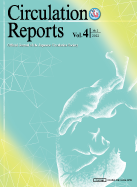4 巻, 1 号
選択された号の論文の12件中1~12を表示しています
- |<
- <
- 1
- >
- >|
Original Articles
Epidemiology
-
原稿種別: ORIGINAL ARTICLE
専門分野: Epidemiology
2022 年 4 巻 1 号 p. 1-8
発行日: 2022/01/07
公開日: 2022/01/07
[早期公開] 公開日: 2021/11/16PDF形式でダウンロード (466K) HTML形式で全画面表示 -
原稿種別: ORIGINAL ARTICLE
専門分野: Epidemiology
2022 年 4 巻 1 号 p. 9-16
発行日: 2022/01/07
公開日: 2022/01/07
[早期公開] 公開日: 2021/11/20PDF形式でダウンロード (829K) HTML形式で全画面表示
Heart Failure
-
原稿種別: ORIGINAL ARTICLE
専門分野: Heart Failure
2022 年 4 巻 1 号 p. 17-24
発行日: 2022/01/07
公開日: 2022/01/07
[早期公開] 公開日: 2021/11/18PDF形式でダウンロード (1623K) HTML形式で全画面表示 -
原稿種別: ORIGINAL ARTICLE
専門分野: Heart Failure
2022 年 4 巻 1 号 p. 25-28
発行日: 2022/01/07
公開日: 2022/01/07
[早期公開] 公開日: 2021/12/03PDF形式でダウンロード (646K) HTML形式で全画面表示
Imaging
-
原稿種別: ORIGINAL ARTICLE
専門分野: Imaging
2022 年 4 巻 1 号 p. 29-37
発行日: 2022/01/07
公開日: 2022/01/07
[早期公開] 公開日: 2021/12/03PDF形式でダウンロード (1377K) HTML形式で全画面表示
Ischemic Heart Disease
-
原稿種別: ORIGINAL ARTICLE
専門分野: Ischemic Heart Disease
2022 年 4 巻 1 号 p. 38-47
発行日: 2022/01/07
公開日: 2022/01/07
[早期公開] 公開日: 2021/12/01PDF形式でダウンロード (6133K) HTML形式で全画面表示
Medical Economy
-
原稿種別: ORIGINAL ARTICLE
専門分野: Medical Economy
2022 年 4 巻 1 号 p. 48-58
発行日: 2022/01/07
公開日: 2022/01/07
[早期公開] 公開日: 2021/11/17PDF形式でダウンロード (931K) HTML形式で全画面表示
Brief Reports
-
原稿種別: BRIEF REPORT
2022 年 4 巻 1 号 p. 59-65
発行日: 2022/01/07
公開日: 2022/01/07
[早期公開] 公開日: 2021/11/30PDF形式でダウンロード (909K) HTML形式で全画面表示
Images in Cardiovascular Medicine
-
原稿種別: IMAGES IN CARDIOVASCULAR MEDICINE
2022 年 4 巻 1 号 p. 66-67
発行日: 2022/01/07
公開日: 2022/01/07
[早期公開] 公開日: 2021/11/11PDF形式でダウンロード (867K) HTML形式で全画面表示 -
原稿種別: IMAGES IN CARDIOVASCULAR MEDICINE
2022 年 4 巻 1 号 p. 68-69
発行日: 2022/01/07
公開日: 2022/01/07
[早期公開] 公開日: 2021/12/10PDF形式でダウンロード (3873K) HTML形式で全画面表示
Corrigendum
-
原稿種別: CORRIGENDUM
2022 年 4 巻 1 号 p. 70-71
発行日: 2022/01/07
公開日: 2022/01/07
PDF形式でダウンロード (323K) HTML形式で全画面表示
-
2022 年 4 巻 1 号 p. Content1-
発行日: 2022/01/10
公開日: 2022/01/07
PDF形式でダウンロード (659K)
- |<
- <
- 1
- >
- >|
